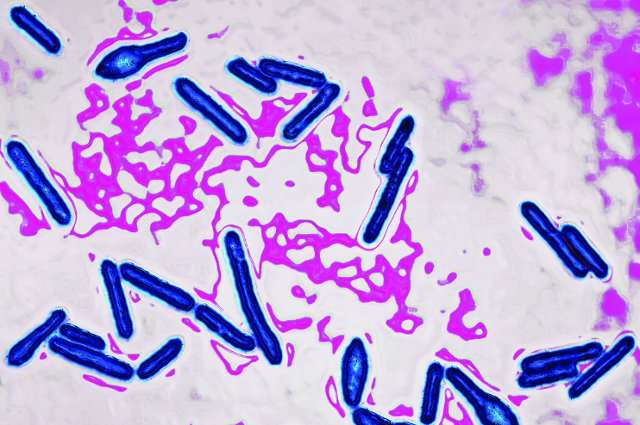Gene therapy for botulism

Gene therapy could be more effective than existing treatments for botulism, a rare paralytic illness caused by a nerve toxin, according to an infectious disease researcher at Cummings School.
The new approach might also be able to be used to treat other more common infections, such as E. coli food poisoning and the hospital-acquired superbug known as Clostridium difficile.
Botulism is caused by a toxin produced by the soil-borne bacterium C. botulinum. People typically get sick when they eat improperly preserved or canned food. Despite the relatively small number of botulism poisoning cases in the U.S., globally there is a serious concern that the toxin—the most potent one known—can be produced easily and inexpensively as a bioterrorism weapon.
There is a vaccine for botulism, but it would be impractical and expensive to inoculate everyone against something they'll probably never get. A widespread vaccination campaign also would prevent the use of the C. botulinum toxin in Botox treatments for medical conditions such as muscle spasms or for cosmetic applications. Instead, physicians treat botulism poisoning with antitoxins.
However, antitoxins are costly to develop, store and deliver—and they have a short shelf life. "Attacking botulism is complicated because various strains of the bacterium produce at least seven known yet very different forms of the same toxins," says Charles Shoemaker, a professor in the Department of Infectious Disease and Global Health at Cummings School. "So you can't just think about dealing with one toxin; you have to deal with all of them."
Antitoxins are currently made by immunizing animals against botulism so they generate antibodies in their blood. These are extracted and used to attack the toxin in humans. The healing occurs when the antibodies bind to the botulism toxins, which are neutralized and flushed out through the liver.
Toxin Neutralizer
Shoemaker came up with a different way of treating botulism poisoning in 2010, when he developed a therapy that employs proteins to neutralize the toxins. By linking the proteins like beads on a string, a single agent can neutralize multiple toxins.
This method offers enormous advantages over the existing treatment, Shoemaker says, because the proteins can be produced cheaply in commercial fermenters and have a longer shelf life than the serum antibodies derived from animals. These new antitoxin proteins could be stored and ready to go at hospitals across the country. Currently, the Centers for Disease Control (CDC) stockpiles the traditional antitoxins in only a few locations.
Shoemaker has advanced his initial discovery by demonstrating that gene therapy can deliver the same antitoxin protein to confer vaccine-like protection against botulism for months at a time, without negating the ability to use Botox as a treatment for other conditions.
The gene therapy uses an engineered adenovirus—essentially a deactivated version of the bug that causes the common cold—to deliver the genes to produce Shoemaker's protein-based botulism treatment. This genetic do-it-yourself kit allows a patient's body to make the protein on its own. "The patient is just as protected as if you had administered the proteins directly," he says.
The gene therapy works in mice. Shoemaker and colleagues from Cummings School and Washington University found that a single treatment protected the mice from subsequent exposures to the C. botulinum toxin for up to several months. The research, funded by the National Institutes of Health, was published in the scientific journal PLOS ONE in August 2014.
Virtually all the mice that received the gene therapy survived a lethal dose of botulinum toxin when exposed within two months after just one treatment; protection against the toxin began to wane after that. The therapy also appears to confer immunity quickly: The mice survived when they were treated even 90 minutes after they were exposed to botulinum.
Thwarting Bioterrorism and Disease
The discovery could have a range of applications, from making new agents that protect military personnel from bioterrorist attacks to developing treatments that thwart other diseases caused by toxin-producing bacteria, Shoemaker says.
Researchers at Cummings School are trying to develop similar gene therapies for severe gastrointestinal diseases, including the Shiga toxins produced in fatal cases of E. coli food poisoning, and Clostridium difficile, which causes nearly 30,000 deaths in the U.S. each year, according to the CDC.
Most recently, Cummings School researchers reported that gene therapy with an antitoxin agent developed by Shoemaker was highly effective in protecting piglets against fatal brain damage after they were infected with Shiga toxin-producing E. coli. Their study, which was led by Assistant Professor Abhineet Sheoran and Saul Tzipori, Distinguished Professor and chair of the Department of Infectious Diseases and Global Health, was published in Infection and Immunity in November 2014.
"The best part of gene therapy is that it's very versatile," says Shoemaker. "You can engineer it so the body produces a toxin-fighting protein for a short or long time, depending on what you need."
For example, patients with Clostridium difficile often undergo treatment for weeks or months to prevent relapses of the serious intestinal disease. "But with gene therapy," he adds, "a patient's body could produce the proteins needed to neutralize the harmful toxins, halting any further damage until the bug producing the toxins is successfully treated."

















